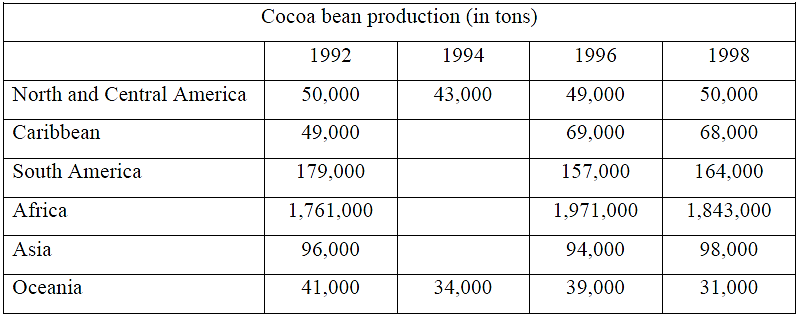GIẢI ĐỀ WRITING NGÀY 26/10/2019
Task 1:
The table shows the production of cocoa beans in six regions from 1992 to 1998.

The table illustrates how many tons of cocoa beans were produced in six regions between 1992 and 1998.
As can be seen from the table, the region with the lowest cocoa bean production was Oceania where the number fluctuated with a downward trend between 41,000 tons in 1992 and 31,000 tons in 1998. A fluctuating trend was also reported for North and Central America with its maximum production of 50,000 tons in 1992, and 1998. Having the similar modest cocoa bean output, Caribbean, despite the missing data for 1994, experienced an increase in the yield of cocoa beans from only 49,000 tons in 1992 to 68,000 tons six years later.
The same absence of data for 1994 was also seen in the regions with high production of cocoa beans, namely South America, Africa, and Asia. However, the most striking figures were found in this group where the highest production were recorded for Africa with the number starting at 1,761,000 tons in 1992, rising to a peak of the whole table at 1,971,000 tons in 1994, and then dropping slightly to 1,843,000 tons in 1998. South America came second, with numbers being only 1/10 of Africa’s figure and fluctuating with a downward trend from 179,000 tons in 1992 to 164,000 tons in 1998. The third ranking region was Asia which produced from 94,000 to 98,000 tons of cocoa beans in the period.
Overall, almost all regions witnessed the fluctuations of cocoa bean production over the period, and the main players in this field were Africa, South America and Asia. (258 words)
Task 2:
Although more and more people read the news on the internet, newspapers will remain an important sources of news for the majority of people. Do you agree or disagree?
Together with the prevalence of facilities for people to connect to the Internet around the clock, there comes the question of whether newspapers still hold their central role in the competition with online news in providing information to the majority of people. I believe that the heyday of newspaper has been over when they show too many inferiorities to electronic news.
Newspapers are not in the league of (không cùng đẳng cấp với) online news regarding convenience. First, if readers are in need of searching for some information of the past issues, (các số báo cũ) instead of rummaging about (lục tung lên) the whole pile of newspapers, some of which may be lost or even discarded, readers can type in the keywords find it easily with Google search engine or even the search box inside the news page. Second, when news readers move from one place to another, instead of carrying cumbersome (cồng kềnh) newspapers, they only need to take their cell phones or some other hand-held devices to access the internet to read news. Third, newspapers do not enable embedded links to different articles with the same topic was it is in online news; therefore, it may fail to fully satisfy people’s demand for getting more topical news.
Moreover, newspapers are also inferior to online news in terms of quality. Indeed, while online articles can include multimedia contents like pictures or videos in seemingly unlimited number, newspapers can only afford very restricted coverage (diện tích trang báo) for pictorial content not to mention its incapability to display videos. This fact proves that online news is much more eye catching and attention grabbing than its paper counterpart. Additionally, while online news can release information up to the minute (cập nhật đến từng phút) for such hot news as the one about the number of casualties and the victims’ identity in the illegal immigration into the UK in 2019 killing 39 Vietnameses, newspapers have to go through editing and printing for release the next day. The demand for speed of such news obviously render newspapers redundant (thừa thải) in the provision of timely and necessary information for those in need.
In conclusion, the lower convenience and quality in its display as well as updating speed make newspapers fall behind (thua kém) online news and thus will not be read by the majority of people in this increasingly digital world. (around 360 words)



